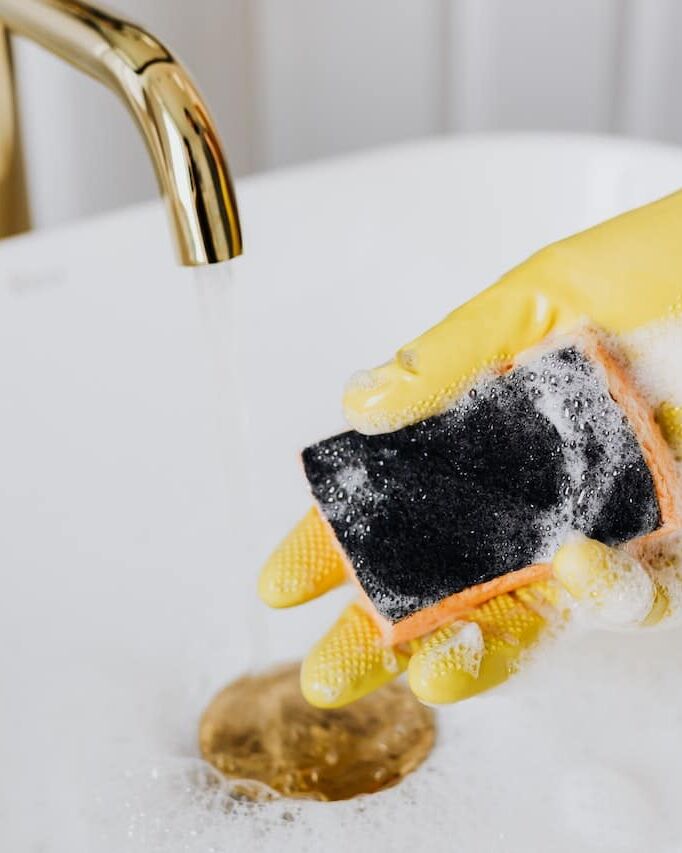We all know the problem with limescale and limescale deposits on the tiles in the bathroom. It looks ugly and the tiles in the bathroom don’t come into their own. It can sometimes seem like an unmanageable project to remove stubborn limescale residues from the bathroom tiles.
Fortunately, there is advice to be had. With the right procedure, you can actually get rid of lime deposits on the tiles.
Here we give you our best advice on how to remove stubborn limescale from your tiles. If you want more cleaning tips, you can also read ours blog posts on how to clean bathroom tiles or properly clean terrazzo .
Why does limescale appear on the tiles?
Limescale on the tiles is a problem that most people can nod in recognition of. Lime deposits are white, hard deposits that form when hard water hits the tiles and evaporates. It is typically water with high levels of lime and other minerals that settle on the surface and form a surface with stubborn white spots.
The reason why lime deposits are often found in bathrooms is because the water is often in contact with the tiles in the bathroom. There is a greater risk of limescale deposits, especially in shower niches and at sinks that are exposed to large amounts of water during the day. Therefore, it is most often here that most people experience major problems with stubborn limescale.
Once the lime residue has stuck to the tiles, it can be difficult to get rid of. Unless you are thorough with the cleaning and maintenance of the tiles in the bathroom, limescale on the tiles and joints will be almost inevitable.
Fortunately, there are a number of good tips and tricks you can try when you want to remove stubborn limescale from the bathroom tiles.

How do you prevent lime deposits on the tiles?
If you want to prevent lime on the tiles, it is a good idea to learn how to clean and maintain the tiles correctly. One of the things that is important to remember is to wipe down the tiles after you have showered or washed your hands at the sink. It prevents the water droplets from drying on the tiles and leaving limescale deposits.
Prevent limescale with regular cleaning of the tiles
Regular cleaning of the bathroom can also be a good idea if you struggle with stubborn limescale. In this way, you avoid having to fight with limescale residues that can be close to impossible to get rid of. Frequent and thorough cleaning removes any incipient limescale deposits before they start to settle.
If you live in an area where the water is very hard, you may also consider installing a water softener in your home. It can help to reduce the amount of lime and minerals in the water, which ultimately means less lime deposits on the tiles.

You need it to remove limescale from tiles and joints
When you want to remove limescale from the tiles in the bathroom, you must use:
- A scrubbing sponge (and possibly a toothbrush)
- Cloth
- Glass scraper
- Gloves
- Cleaning agent or Descaling agent
It varies which type of cleaning agent is best for removing limescale from tiles and joints. If you have a reasonable amount of limescale on the tiles, you can try your hand at a very simple household tip and use vinegar or lemon juice to remove the limescale. It is more gentle and environmentally friendly compared to other descaling agents, and can therefore easily be used if you have minor limescale deposits in the bathroom.
If you want to use a stronger agent, you can also use a limescale remover with citric acid or acetic acid to remove limescale from the tiles.
These types of surfaces cannot withstand acid
It is important to be aware that natural stone surfaces, such as lava stone and terrazzo tiles, does not tolerate acidic cleaning agents. The same applies to joints and enamelled surfaces.
Here, it is instead important to use either liquid brown soap, soap shavings or a cleaning agent specially developed for natural stone to remove limescale from the tiles. It is much gentler on the tiles and prevents damage to the surface. Marble surfaces also benefit from a damp microfiber cloth and warm water, which is both effective and gentle.
See also: Our entire selection of bathroom tiles .

Here’s how you do it:
- Start by making the tiles wet and scrape them down with a glass scraper. It is important that the joints are saturated with water, as they cannot tolerate acid. It forms a membrane that protects them.
- Apply a layer of vinegar or citric acid – depending on the type of cleaning agent you choose to use. Rub it on the tiles with a scouring sponge or a toothbrush and let it work until it dissolves, approx. 15-30 minutes.
- If you use vinegar, you can simply wash the tiles down with a cloth. Optionally, let the vinegar sit for a few hours, or overnight, before moving on to the rest of the steps.
- Scrub the tiles with a brush and rinse thoroughly with clean water.
- Wipe the tiles afterwards with a clean, dry tea towel or a dry cloth.
Use knuckle grease for the joints
When you clean the joints of dirt, it usually requires a good amount of knuckle grease to dissolve and remove the dirt and lime that has accumulated. Here you can use a universal cleaner and a toothbrush or a scouring pad to clean the joints. The most important thing is that you use an acid-free cleaning agent, such as this one of the joint .
How to remove scale from terrazzo and marble
If you already have problems with limescale and stubborn limescale deposits on your marble or terrazzo tiles, you can try to remove it with a natural stone cleaner, such as the products from Stonetreatment .
Here’s how you do it:
Apply the cleaning agent to the surface, let it work as directed on the packaging and scrub the tiles gently. Rinse thoroughly with clean water before finally drying the surface. The products have been specially developed to remove dirt, grime and limescale from surfaces made of natural stone, and are therefore free of acids. At the same time, the products help to maintain the natural colors and structures of the stone.
Maintain the tiles in the bathroom
To keep the tiles in the bathroom nice and shiny, it is a good idea to maintain them properly. This can possibly be done by applying a impregnation , which forms a protective membrane on the tiles. Also remember to repeat the cleaning process of tiles and joints at regular intervals to keep them nice and resistant for many years to come.
Are you in doubt about which tiles to choose for the bathroom? Read our blog post about choosing tiles and get inspired to choose the right bathroom tiles.


